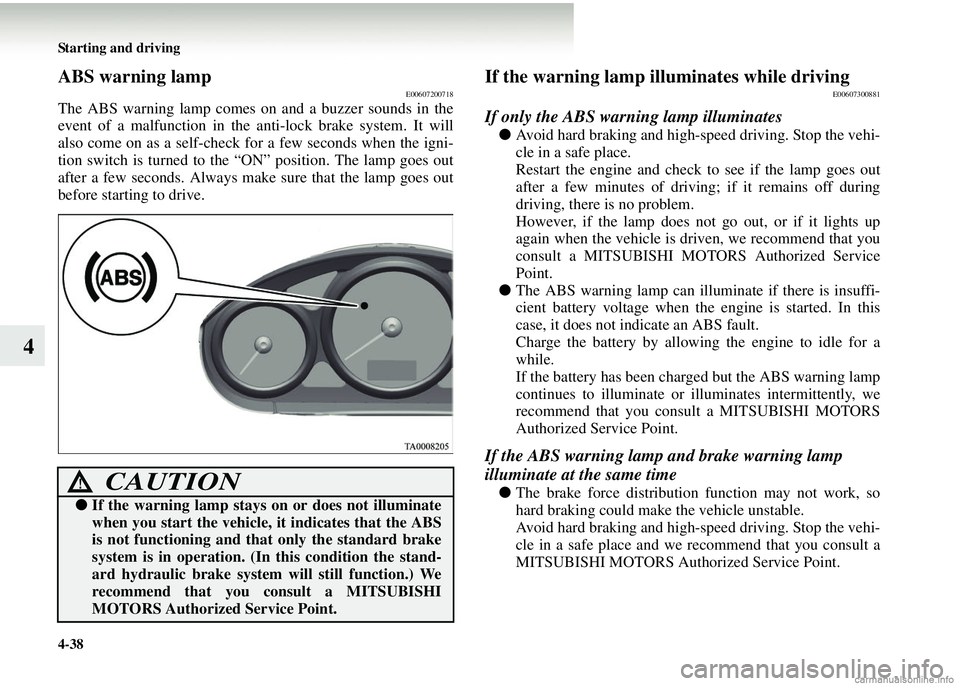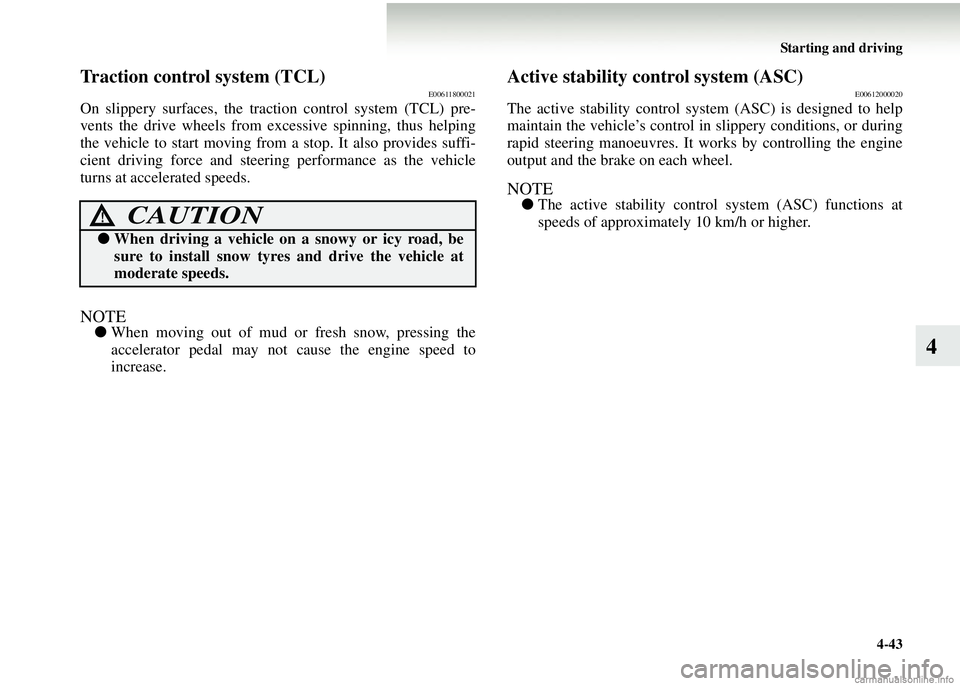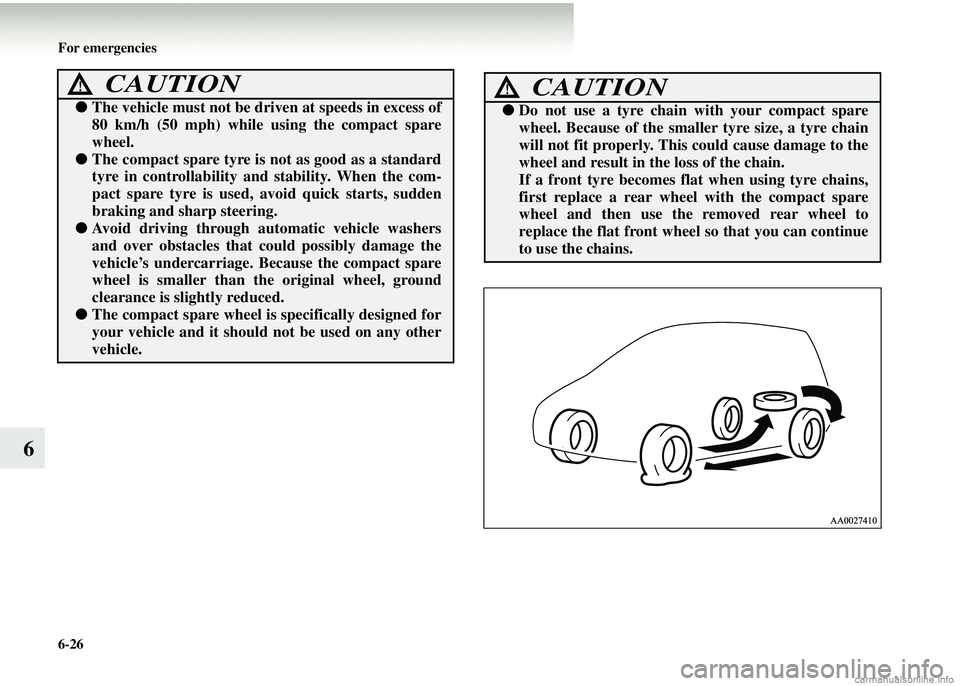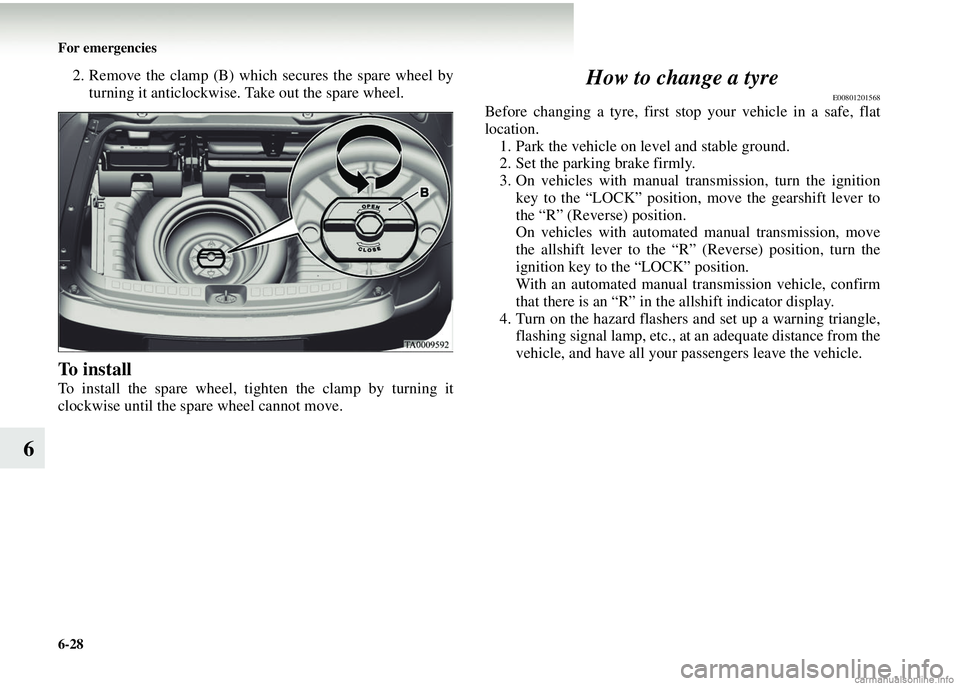stab MITSUBISHI COLT 2008 (in English) User Guide
[x] Cancel search | Manufacturer: MITSUBISHI, Model Year: 2008, Model line: COLT, Model: MITSUBISHI COLT 2008Pages: 450, PDF Size: 14.57 MB
Page 204 of 450

4-38 Starting and driving
4
ABS warning lampE00607200718
The ABS warning lamp comes on and a buzzer sounds in the
event of a malfunction in the anti-lock brake system. It will
also come on as a self-check for a few seconds when the igni-
tion switch is turned to the “ON” position. The lamp goes out
after a few seconds. Always make sure that the lamp goes out
before starting to drive.
If the warning lamp illuminates while drivingE00607300881
If only the ABS warning lamp illuminates
● Avoid hard braking and high-speed driving. Stop the vehi-
cle in a safe place.
Restart the engine and check to see if the lamp goes out
after a few minutes of driving; if it remains off during
driving, there is no problem.
However, if the lamp does not go out, or if it lights up
again when the vehicle is dr iven, we recommend that you
consult a MITSUBISHI MOTORS Authorized Service
Point.
● The ABS warning lamp can illuminate if there is insuffi-
cient battery voltage when the engine is started. In this
case, it does not indicate an ABS fault.
Charge the battery by allowing the engine to idle for a
while.
If the battery has been charged but the ABS warning lamp
continues to illuminate or illuminates intermittently, we
recommend that you cons ult a MITSUBISHI MOTORS
Authorized Service Point.
If the ABS warning lamp and brake warning lamp
illuminate at the same time
● The brake force distribution function may not work, so
hard braking could make the vehicle unstable.
Avoid hard braking and high-speed driving. Stop the vehi-
cle in a safe place and we recommend that you consult a
MITSUBISHI MOTORS Authorized Service Point.CAUTION!
●If the warning lamp stays on or does not illuminate
when you start the vehicle, it indicates that the ABS
is not functioning and that only the standard brake
system is in operation. (I n this condition the stand-
ard hydraulic brake system will still function.) We
recommend that you consult a MITSUBISHI
MOTORS Authorized Service Point.
Page 208 of 450

4-42 Starting and driving
4Traction control system (TCL)/Active
stability control system (ASC)
*
E00611700033
The traction control system (TCL )/active stability control sys-
tem (ASC) takes overall control of the anti-lock brake system,
traction control system and activ e stability control system to
help maintain the vehicle’s control and traction. Please read
this section in conjunction with the page on the anti-lock brake
system, traction control system and active stability control sys-
tem.
Anti-lock brake system (ABS) → P. 4-36
Traction control system (TCL) → P. 4-43
Active stability control system (ASC) → P. 4 - 4 3
NOTE● Immediately after the vehicle starts moving after engine
start up, a whining sound of a motor will be heard from
the engine compartment. If the brake pedal is depressed at
that moment, a brake pedal pulsating is felt.
This whining sound and pulsation are due to the self-diag-
nosis operation of the traction control system (TCL)/
active stability control system (ASC) and does not indi-
cate a malfunction.
● Some vibration will be felt in the vehicle body and a
whining sound of a motor will be heard from the engine
compartment when the tract ion control system (TCL)/
active stability control system (ASC) functions. This is a
normal result of the traction control system (TCL)/active
stability control system (ASC) operation, and does not
indicate a malfunction.
● The traction control system (T CL)/active stability control
system (ASC) does not operate while the ABS warning
lamp is illuminated.
CAUTION!
● Do not over-rely on the traction control system
(TCL)/active stability control system (ASC). Even
when the traction control system (TCL)/active sta-
bility control system (ASC ) is operating, there are
limits to the system and its ability to maintain con-
trol and traction. Reckless driving may lead to acci-
dents. Always drive carefully, taking account of the
road conditions.
● Be sure to use the same specified type and size of
tyre on all 4 wheels. Otherw ise, there is a possibility
that the traction control system (TCL)/active stabil-
ity control system (ASC) will not work properly.
Page 209 of 450

Starting and driving4-43
4
Traction control system (TCL)E00611800021
On slippery surfaces, the traction control system (TCL) pre-
vents the drive wheels from exces sive spinning, thus helping
the vehicle to start m oving from a stop. It also provides suffi-
cient driving force and steerin g performance as the vehicle
turns at accelerated speeds.
NOTE● When moving out of mud or fresh snow, pressing the
accelerator pedal may not cause the engine speed to
increase.
Active stability control system (ASC)E00612000020
The active stability control syst em (ASC) is designed to help
maintain the vehicle’s control in slippery conditions, or during
rapid steering manoeuvres. It works by controlling the engine
output and the brake on each wheel.
NOTE● The active stability control system (ASC) functions at
speeds of approximately 10 km/h or higher.CAUTION!
● When driving a vehicle on a snowy or icy road, be
sure to install snow tyre s and drive the vehicle at
moderate speeds.
Page 210 of 450

4-44 Starting and driving
4
Traction control system (TCL)/Active stability
control system (ASC) indicator lamp
E00612100092
The traction control system (TCL ) and active stability control
system (ASC) share the same indicator lamp.
The indicator lamp should illuminate when the ignition switch
is turned to the “ON” position, and should go off after a few
seconds. Always make sure that the lamp goes off before
begining to drive.
If the indicator lamp stays on or does not illuminate when the
ignition switch is turned to the “ON” position, we recommend
that you consult a MITSUBISHI MOTORS Authorized Serv-
ice Point.
indicator lamp blinks when the traction control system
(TCL) or active stability contro l system (ASC) is operating.
CAUTION!
●When the indicator lamp blinks, the traction con-
trol system (TCL) or acti ve stability control system
(ASC) is operating, which means that the road is
slippery or that your vehicle’s wheels are slipping
excessively. If this happens, drive more slowly with
less accelerator input.
● If a malfunction occurs in the device, the indica-
tor lamp will illuminate continuously. Park your
vehicle in a safe place and stop the engine. Then
start the engine again and check whether the
indicator lamp goes out.
If the indicator lamp re mains on even after your
vehicle is driven a short distance after starting the
engine, we recommend that you consult a
MITSUBISHI MOTORS Authorized Service Point.
Page 211 of 450

Starting and driving4-45
4
Cargo loads
E00609900168
Cargo load precautions
CAUTION!
●
If the vehicle is towed with the ignition switch in the
“ON” position and only the front wheels or only the
rear wheels are raised off the ground, the traction
control system (TCL) may operate, resulting in an
accident. When towing th e vehicle with the front
wheels raised, keep the ig nition switch in the
“LOCK” or “ACC” position. When towing the vehi-
cle with the rear wheels raised, keep the ignition
switch in the “ACC” position.
Refer to “Towing” on page 6-36.
CAUTION!
● Do not load cargo or luggage higher than the top of
the seat-back. Be sure that your cargo or luggage
cannot move once your vehicle is moving.
Having either the rear view blocked, or your cargo
being thrown inside the cabin if you suddenly have
to brake can cause a serious accident or injury.
●Load heavy cargo or luggage in the front of the vehi-
cle. If the load in the back of the vehicle is too heavy,
steering may become unstable.
Page 277 of 450

For pleasant driving5-61
5
NOTE●Long use of the electric appliance without running the
engine may run the battery down.
Interior lamps
E00712000265
Vehicles without ke yless entry system
The interior lamps go on when a door or tailgate is opened.
When all doors and tailgate are closed, the interior lamps are
illuminated and dimmed gradually for 7 seconds then go out.
However, the interior lamps go out immediately without being
dimmed if the ignition switch is turned “ON”.
Vehicles with keyless entry system
The interior lamps go on when a door or tailgate is opened.
When all doors and tailgate are closed, the interior lamps are
illuminated and dimmed gradually for 15 seconds then go out.
However, the interior lamps go out immediately without being
dimmed in the following cases: ● The ignition switch is turned “ON”.
● All doors and tailgate are lo cked using the key mechanism
of the driver’s door, the lock knob of the driver’s door, or
the remote control switch of the keyless entry system.
NOTE●The dimming period is adjustable.
For further information, we recommend you to consult a
MITSUBISHI MOTORS Auth orized Service Point.
● On vehicles with the Dead Lock System, if the ignition
key is removed with the doors closed, the interior lamps
are dimmed gradually for 15 seconds then go out.
● If you leave the lamps on without running the engine, you
will run down the battery. Before you leave the vehicle,
make sure that all the lamps are off.
● When the accessory socket is not in use, be sure to
close the cap, because the socket might become
clogged by foreign material and be short-circuited.
CAUTION!
Page 303 of 450

For emergencies6-13
6
• The tyre is punctured in the side wall (A), not in thetread (B).
• The vehicle has been driven with the tyre almost com-
pletely flat.
• The tyre has completely sl ipped over the wheel rim and
come off the wheel.
• The wheel is damaged.
● Only use the tyre sealant at ambient temperatures of -
20 °C to + 60 °C.
● Effect an emergency repair without pulling out the object
(nail, screw, etc.) that is stuck in the tyre.
● Do not use the tyre sealant if the tyre has been damaged
by being driven when insufficiently inflated (e.g. bumps,
cuts, cracks, etc. on the tyre).
● Wipe tyre sealant off paintwork immediately with a damp
cloth. ●
Immediately wash out any clot hes contaminated with the
tyre sealant.
Before repairing a tyre, first stop your vehicle in a safe, flat
location. 1. Park the vehicle on level and stable ground.
2. Set the parking brake firmly.
3. On vehicles with manual transmission, turn the ignition key to the “LOCK” position, move the gearshift lever to
the “R” (Reverse) position.
On vehicles with automated manual transmission, move
the allshift lever to the “R” (Reverse) position, turn the
ignition key to the “LOCK” position.
With an automated manual transmission vehicle, confirm
that there is an “R” in th e allshift indicator display.
4. Turn on the hazard flashers and set up a warning triangle, flashing signal lamp, etc., at an adequate distance from the
vehicle, and have all your passengers leave the vehicle.
Page 313 of 450

For emergencies6-23
6
Jacking up the vehicle
E00801001016
1. Park the vehicle on level and stable ground.
2. Set the parking brake firmly.
3. On vehicles with manual transmission, turn the ignition
key to the “LOCK” position, move the gearshift lever to
the “R” (Reverse) position.
On vehicles with automated manual transmission, move
the allshift lever to the “R” (Reverse) position, turn the
ignition key to the “LOCK” position.
With an automated manual tr ansmission vehicle, confirm
that there is an “A” or “1” in the allshift indicator display.
4. Turn on the hazard flashers and set up a warning triangle,
flashing signal lamp, etc., at an adequate distance from the
vehicle, and have all your passengers leave the vehicle. 5. To prevent the vehicle from roll
ing when it is raised on the
jack, place a chock or block (A) at the tyre that is diago-
nally opposite from the tyre (B) you are changing.
NOTE● The chock shown in the illustration does not come with
your vehicle. It is recommended that you keep one in the
vehicle for use if needed.
● If a chock is not available, use a stone or any other object
that is large enough to hold the wheel in position.
WARNING!
●Be sure to apply a chock to the correct tyre when
jacking up the vehi cle. If the vehicle moves while
jacked up, the jack could slip out of position and
cause an accident.
Page 316 of 450

6-26 For emergencies
6
●The vehicle must not be driven at speeds in excess of
80 km/h (50 mph) while using the compact spare
wheel.
● The compact spare tyre is not as good as a standard
tyre in controllability and stability. When the com-
pact spare tyre is used, avoid quick starts, sudden
braking and sharp steering.
●Avoid driving through au tomatic vehicle washers
and over obstacles that could possibly damage the
vehicle’s undercarriage. Because the compact spare
wheel is smaller than th e original wheel, ground
clearance is slightly reduced.
● The compact spare wheel is specifically designed for
your vehicle and it should not be used on any other
vehicle.
CAUTION!CAUTION!
● Do not use a tyre chain with your compact spare
wheel. Because of the small er tyre size, a tyre chain
will not fit properly. This could cause damage to the
wheel and result in the loss of the chain.
If a front tyre becomes flat when using tyre chains,
first replace a rear wheel with the compact spare
wheel and then use the removed rear wheel to
replace the flat front wheel so that you can continue
to use the chains.
Page 318 of 450

6-28 For emergencies
6
2. Remove the clamp (B) which secures the spare wheel byturning it anticlockwise. Take out the spare wheel.
To install
To install the spare wheel, ti ghten the clamp by turning it
clockwise until the sp are wheel cannot move.
How to change a tyre
E00801201568
Before changing a tyre, first stop your vehicle in a safe, flat
location.
1. Park the vehicle on level and stable ground.
2. Set the parking brake firmly.
3. On vehicles with manual transmission, turn the ignition key to the “LOCK” position, move the gearshift lever to
the “R” (Reverse) position.
On vehicles with automated manual transmission, move
the allshift lever to the “R” (Reverse) position, turn the
ignition key to the “LOCK” position.
With an automated manual tran smission vehicle, confirm
that there is an “R” in th e allshift indicator display.
4. Turn on the hazard flashers an d set up a warning triangle,
flashing signal lamp, etc., at an adequate distance from the
vehicle, and have all your passengers leave the vehicle.